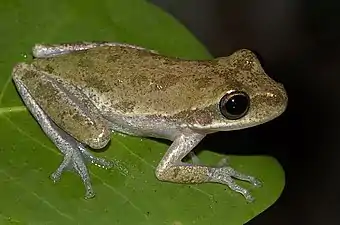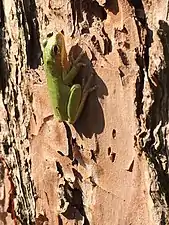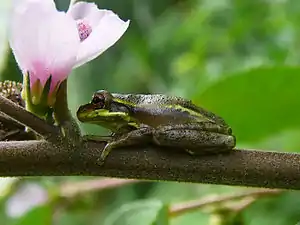Squirrel tree frog
The squirrel tree frog (Dryophytes squirellus) is a small species of tree frog found in the south-eastern United States, from Texas to Virginia. This is an introduced species in the Bahamas.
| Squirrel tree frog | |
|---|---|
 | |
| Scientific classification | |
| Kingdom: | Animalia |
| Phylum: | Chordata |
| Class: | Amphibia |
| Order: | Anura |
| Family: | Hylidae |
| Genus: | Dryophytes |
| Species: | D. squirellus |
| Binomial name | |
| Dryophytes squirellus (Daudin, 1800) | |
| Synonyms | |
Squirrel tree frogs are small frogs, about 1.5 inches in length as adults. There are several color variations, but most commonly they are green and look very much like the American green tree frog. They can also be varying shades of yellow or brown, sometimes with white or brown blotching.
Predation
As tadpoles, the squirrel tree frog is preyed upon by dragonfly nymphs, giant water bugs, predatory fish and newts.[1][2] Once the tadpoles metamorphose, the predators of the frogs change to small mammals, other frogs, snakes, birds.[1]
To reduce the danger of being eaten as tadpoles, they use dense vegetation as cover.[3] However, they do not appear to reduce activity within this cover. It has been suggested that the drying of the ponds is a more significant threat to the frogs than predation. As adults, they use their diminutive size and color-changing ability to avoid predation.[4] When not feeding, the frog reduces activity and hides in a retreat; frogs feed within 28 meters of this retreat site.[1]
Diet
The tadpoles are suspension feeders that scrape organic and inorganic matter from rocks, plants and log substrates. Adult squirrel tree frogs are very aggressive predators on insects and other invertebrates. They have been observed visiting porch lights in the evening to catch the bugs drawn in by the lights and circling piles of fresh cow-dung to devour the midges that were attracted to the cow-dung. An examination of tree frog stomachs found that nine were empty; four contained beetles; two contained only plant debris; and the rest contained a mixture of crayfish, spiders, crickets, and ants. Tree frogs' eating habits are affected by geographic location, weather, and developmental stage.
Distribution
Squirrel tree frogs are found in the southeastern United States, from Virginia to Eastern Texas to the Florida Keys. The species is prominent throughout the Coastal Plain regions of South Carolina and Georgia.[5] They have recently been introduced to the Bahamas, on Grand Bahama Island and Little Bahama Bank.[6] They very rarely are found as far north as Mississippi. They occupy a wide range of habitats including fields; urbanized areas; swamps; pine and oak groves; opened wooded areas; the sides of buildings and almost anywhere that food, moisture and shelter can be found. They return to wetlands to breed, typically in locations such as ephemeral pools, roadside ditches or canopy pools where they are safe from predatory fish.[7]
Conservation
Squirrel tree frogs are active foragers, even when insect predators are present.[8] They can be found in both open- and heavily-forested wetlands, but they have higher rates of survival in bodies of water with a higher density vegetation.[9] Due to their high levels of activity, squirrel tree frogs tadpoles are vulnerable to predation by multiple species of fish, and the adults are vulnerable to predation by the non-native Cuban tree frog.[10][11]
Because of their rapid growth and development, the tadpoles are more likely to survive insect predators than fish predators.[8] There are multiple species of fish, including Gambusia holbrooki, that are capable of hunting and consuming squirrel tree frog tadpoles within higher density vegetation[3] They are a highly active species that forages throughout the water column, and as a result the tadpoles are vulnerable to many species of fish[11]
The Cuban tree frog is known to eat smaller native frogs including the squirrel tree frog. As the population of the Cuban tree frog has increased in Florida, the native squirrel tree frog population has decreased.[12] When they are reared alongside Cuban tree frogs, squirrel tree frogs have a lower survival rate than when they are reared alone; however, the Cuban tree frog does not appear to be a threat to the squirrel tree frog tadpoles.[9]
Although the squirrel tree frog population has decreased in some urbanized areas, they are abundant in some areas of Augusta, Georgia, and Tampa, Florida. The squirrel tree frog crosses roads at night after rains, but the overall effect of traffic on the population is unknown.[4] The squirrel tree frog has a large population and an ability to adapt to disturbed habitats; as a result, there are few concerns about its conservation status.[13]
Gallery
 USGS photograph
USGS photograph A juvenile
A juvenile Squirrel tree frog on tree in Osceola National Forest, Florida
Squirrel tree frog on tree in Osceola National Forest, Florida At the Fern Forest nature center in Coconut Creek Florida
At the Fern Forest nature center in Coconut Creek Florida
References
- Dodd, Kenneth C. (2013). Frogs of the United States and Canada, Volumes 1 and 2. Johns Hopkins University Press. pp. 288–294. ISBN 9781421410388. OCLC 853495816.
- Tipton, Bob (2012). Texas Amphibians: A Field Guide. University of Texas Press. pp. 192–194. ISBN 9780292742925. OCLC 961605472.
- Baber, Matthew J.; Babbitt, Kimberly J. (2004). "Influence of Habitat Complexity on Predator-Prey Interactions between the Fish (Gambusia holbrooki) and Tadpoles of Hyla squirella and Gastrophryne carolinensis". Copeia. 2004 (1): 173–177. doi:10.1643/ce-03-056r1. JSTOR 1448653.
- "AmphibiaWeb - Hyla squirella". amphibiaweb.org. Retrieved 2017-12-11.
- Virden, Tyler. “Hyla Squirella (Squirrel Treefrog).” Animal Diversity Web, animaldiversity.org/accounts/Hyla_squirella/.
- Schwartz, Albert; Henderson, Robert W. (1991). Amphibians and reptiles of the West Indies : descriptions, distributions, and natural history. Gainesville: University of Florida Press. p. 137. ISBN 9780585192420. OCLC 44958544.
- Hether, T. 2012. machine learning identifies specific habitats associated with genetic connectivity in hyla squirella
- Babbitt, Kimberly J.; Tanner, George W. (1997). "Effects of Cover and Predator Identity on Predation of Hyla squirella Tadpoles". Journal of Herpetology. 31 (1): 128–130. doi:10.2307/1565342. JSTOR 1565342.
- Knight, C.M. (2009). "Influence of priority effects and pond location on invaded larval amphibian communities". Biol. Invasions. 11 (4): 1033–1044. doi:10.1007/s10530-008-9314-2.
- Quick, David (2005). "Invasive predator here from Florida, but can it survive lowcountry winter?". The Post and Courier. ProQuest 374016644.
- Baber, M.J. (2003). "The relative impacts of native and introduced predatory fish on a temporary wetland tadpole assemblage". Oecologia. 136 (2): 289–295. doi:10.1007/s00442-003-1251-2.
- Davidson, Micharl Scot (2014). "Invasive frogs are spreading in Florida". Sarasota Herald Tribune.
- IUCN (2004). "Dryophytes squirellus: Hammerson, G.A. & Hedges, B." IUCN Red List of Threatened Species. 2004. doi:10.2305/iucn.uk.2017-1.rlts.t55662a112715025.en.
External links
| Wikimedia Commons has media related to Hyla squirella. |
